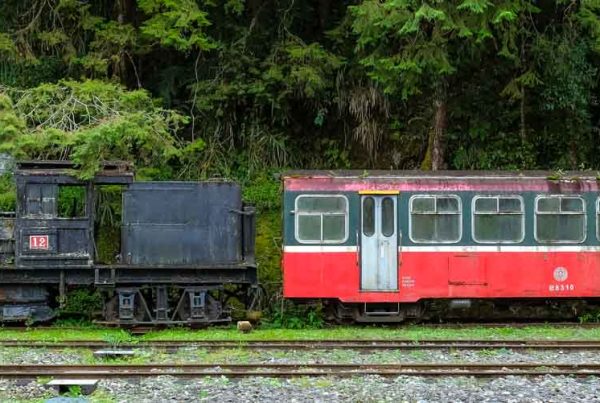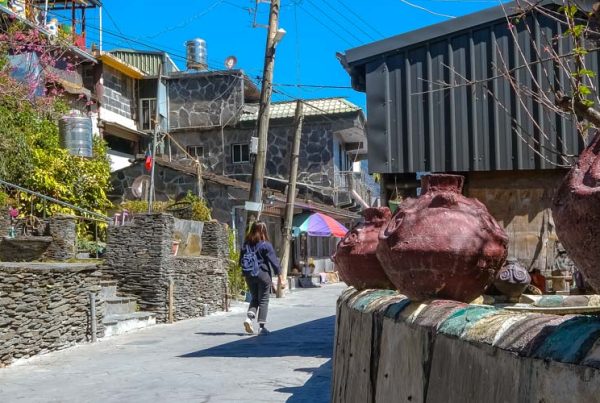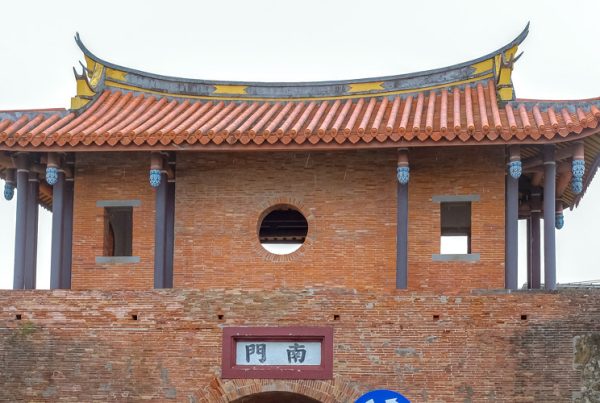A Relaxing Day Taking in Some of the City’s Coolest Places
TEXT | RICK CHARETTE
PHOTOS | VISION
Walk yourself back into history in the city of Tainan’s West Central District, where Taiwan’s oldest Han Chinese settlement took root in the 1600s, and at the same time walk right into some of the city’s most debonair young cultural-creative attractions. We’ve vetted a walkabout route map for you.
Content
Morning
Tainan Art Museum Building 2
Launch your Tainan adventure with the Tainan Art Museum Building 2 (www.tnam.museum), which opens mid-morning. Where are we? In the heritage area immediately east of the Anping Canal’s north section. The area west was open saltwater when the Dutch founded what became Tainan in the 1620s.



Building 2 is a bold, purpose-built new architectural work, likened to a ziggurat or Mars base mockup. The exterior-design inspiration was the flamboyant flame tree (Delonix regia), brought to Taiwan during the 1895~1945 Japanese colonial era, now Tainan’s official tree. The striking pentagonal contours, building block-style layered exhibition spaces, and dramatic fractal roof canopy immediately made this work a Tainan architectural landmark. The facility houses 17 galleries. If needing a break, have a snack at The POOL (5F), an aromatic café offering varied dessert treats that’s also a showcase for glass arts and has great views of Tainan.
You’re wondering, no doubt, about Building 1. It’s just a block away, east. But first, along that block’s walk….
↓
[Distance 450m; 6-min walk]
↓
Tainan Confucius Temple
Tainan Confucius Temple is Taiwan’s oldest temple dedicated to the Great Sage and Teacher. The island’s first – and long its premier – educational institution, it was built in 1665 as incubator for a Chinese cultural renaissance in Taiwan. Renovated numerous times since, this remains the island’s foremost Confucius shrine, showcasing a classical architectural style rare elsewhere. Set in a tranquil garden compound, arched gates and corniced walls separate numerous courtyards, each with its own halls and special functions. These originally served as schools for the different branches of classical Chinese studies.

↓
[200m; 3min]
↓
Tainan Art Museum Building 1
Tainan Art Museum Building 1 looks across an intersection at the temple complex’s northeast corner. An exemplar of Tainan’s love for repurposing older architectural works, this was originally the Tainan Police Agency building, Taiwan’s oldest police edifice, designed and built in Art Deco style by a Japanese architect in 1931. It has 16 galleries.



Note: We aren’t suggesting that you should visit both museums in a single morning! Choose one – better yet, stay more than one day!
↓
[150m; 2min]
↓
Lunchtime
High noon, time to eat! Tainan is famed for good eats using the freshest ingredients produced in the region, and specifically for its snack treats. It’s also renowned for its legion of cafés and characterful eateries, especially ventures housed in tucked-away corners and boldly eclectic. Here we’ve lined up two shining examples for you, both in the same area as our morning destinations. Pace yourself with your food and drink intake, for both are well worth visiting just for the unique cultural-creative ambience!
Narrow Door Café
Just over one block south of the aforementioned Tainan Confucius Temple / Tainan Art Museum Building 1 intersection is the Narrow Door Café (www.facebook.com/narrowdoor99). Its name is more than apt. The “door” in question is a long, narrow slit between two multi-story commercial buildings, which looks like a deep fissure in a cliff, that you have to enter sideways (a Chinese/English sign above the arcade sidewalk here identifies the “door” location). At one building’s rear, you enter the café via steep, plant-shaded stairs. Though foregoing advertising, it boasts a devoted fan base, including local expatriates, who learn of it by word of mouth.


The owner-operator has taken what was originally a home built by a doctor a century ago during the Japanese era and transformed it into a Turkish-style getaway idyll. She still fondly remembers a trip to Safranbolu, a delightfully well-preserved Ottoman-Turkish museum town, and when the cool breezes are wafting in through the café’s large windows you’ll feel you are far, far away. On the menu are specialty coffees, juices, teas, cocktails, light meals such as Thai pork curry and veggie hotpot, and snacks such as dumplings, toasts, croissants, and desserts.


↓
[650m; 9min]
↓
44 Bit Records
About four blocks southeast of our temple/museum intersection is 44 Bit Records (www.facebook.com/44bit) on a languid lane facing a community park, beside a temple office a few doors down. A combo eatery/music-listening oasis, it’s on the ground level in a classic old-style deep and long two-story former residence with an exceedingly narrow façade of yellow brick. In the old-Taiwan retro interior, a long and slender passageway takes you first past the service counter, then a tiny DJ room, then a tiny sky-well, to the compact kitchen. Customer seating is in an attached newly built one-story structure next door that has exposed steel ceiling girders and a façade with a large multi-paned window and both wall covering/window framing made of wood-mimicking steel.


Reflecting the owner’s fondness for electronic music, the space is filled with old records and CDs from around the globe in the DJ room and on stacked racks of DJ equipment. While dining here you’ll be listening to easy-listening, not thumping, album selections. The menu presents teas, tea drinks, and carbonated fruity drinks. Specially recommended food selections are the BBQ chicken with cheese panini and the chicken in peanut sauce (piquant sauce made with peanut, tomato, papaya, spices). These come with fresh organic garden salad, range-chicken egg, and saffron rice.


↓
[1km; 14min]
↓
Afternoon/Evening
As the afternoon rolls in, let’s make our focus a bit of snacking and a bit of shopping to uncover souvenirs that will proclaim “Taiwan!” every time you look at them plus special treasures to bring back home for the folks who hold a special place in your heart. The five spots we’re experiencing are all in the same concentrated area as our morning/lunchtime stops.
Hayashi Department Store
Let’s start our attraction-hopping with Hayashi Department Store (www.facebook.com/hayashi.tw), shall we? This is one block north of Museum Building 2. The multi-story dedicated department store building, opened in 1932, features a harmonious blend of Eastern and Western architectural elements. Hayashi was south Taiwan’s first department store, Taiwan’s second. Abandoned for many decades after Allied bombing in WWII, it was refurbished and reopened last decade. There’s tea, handicrafts and multifarious other Tainan-connected items for sale, a coffee shop on the 4th level, restaurant on the 5th, and on the 6th a sake brewery, Japanese-style food and drink enterprise, and observatory with splendid city views.



↓
[300m; 5min]
↓
Snail Alley
Quirky Snail Alley is just under two blocks north of Building 2. This is a small area of narrow lanes, old residences, and historical buildings bursting with funky installation artworks and, especially, colorful 3D murals. Snails, as one might surmise from the place name, are a favorite subject matter. The enclave is hipster nirvana, also jam-packed with shops and restaurants. The “Snail Alley” name is derived from a fictional alley depicted in a well-known novel by Taiwan novelist and literary scholar Yeh Shih-tao, whose last residence was here.

↓
[210m; 3min]
↓
Bing Xiang
Bing Xiang (www.facebook.com/icecountry160) or “Ice Country,” is two-plus blocks north of Building 2. This simple-decor shop is a purveyor of shaved ice treats that has a special place in the hearts of Tainan locals – it was opened in 1978 and has grown up with them. The secret here is the freshest of fruits; Taiwan has been called the “Kingdom of Fruit,” and Tainan sits within a key production region. Specially recommended is the mango ice and banana ice. The tofu pudding is also esteemed.


↓
[450m; 7min]
↓
Yebisu Kan
The Yebisu Kan (www.facebook.com/yebisukan1935) building, three blocks west/northwest of Museum Building 2, was once home to one of Tainan’s four major movie theaters, from 1935 in the Japanese era until 1961. In 1970 Taiwan’s renowned Black Bridge brand (maker of traditional-style sausages, meat floss, jerky, etc.) moved in and comprehensively renovated the retail facility to resemble a museum. Other iconic old-ways food retailers have also been invited in.



↓
[350m; 5min]
↓
The Spring
We’ll wind down the day at The Spring, perfect for evening scenic photography. It’s about five blocks northwest of Museum Building 2, near the Anping Canal. When the early 1980s-built Tainan Chinatown mall was demolished, the now-mostly-alfresco basement was ingeniously transformed into a 1.54ha public plaza rich with greenery. Selected original beams and columns have been left in place for aesthetic effect. A shallow, clean-water mini-lagoon complete with tree-studded islets was created for kids’ water play (changing rooms available). The place is especially busy during warm-weather months, notably on concert nights.


Further Exploration
Here’s a charismatic quartet that will expand the outlying boundary of your walkabout, though certainly within range for devotees of good exercise:
Tainan Wu Garden is in West Central District’s northeast corner. Built in 1828 by a salt magnate, it’s known as one of the “Four Great Gardens of Taiwan.” Chikan Tower, inside its north-middle edge, features two Chinese imperial-era towers built on the ruins of a 1652-raised Dutch fort. The Blueprint Culture & Creative Park complex, steps outside its south quarter, possesses renovated Japanese-era dorms for judicial-authority employees now housing artisanal outlets and creative eateries. End your day at Shennong Street, not far from Chikan Tower, where cafés, eateries, bars, teahouses, and cultural-creative enterprises today inhabit the Qing- and Japanese-era shophouses.










